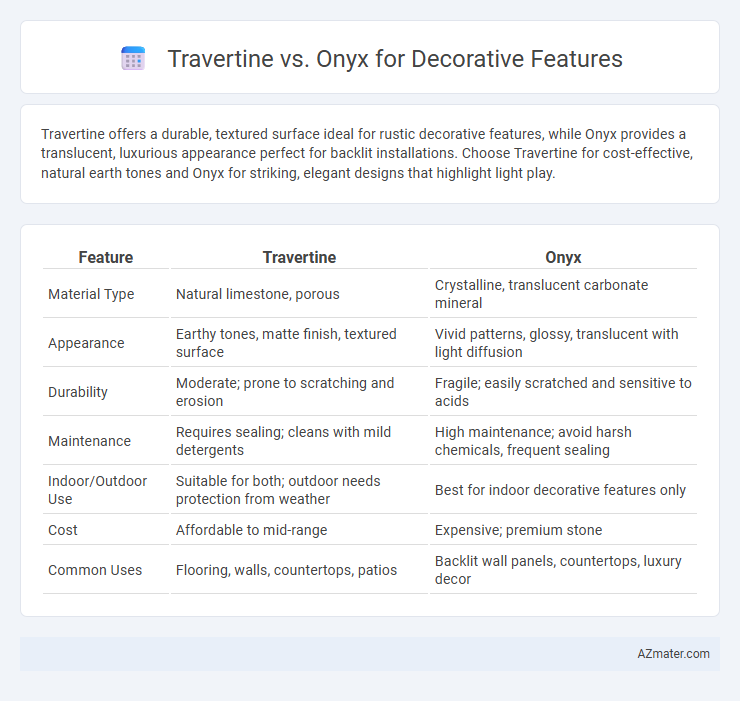Travertine offers a durable, textured surface ideal for rustic decorative features, while Onyx provides a translucent, luxurious appearance perfect for backlit installations. Choose Travertine for cost-effective, natural earth tones and Onyx for striking, elegant designs that highlight light play.
Table of Comparison
| Feature | Travertine | Onyx |
|---|---|---|
| Material Type | Natural limestone, porous | Crystalline, translucent carbonate mineral |
| Appearance | Earthy tones, matte finish, textured surface | Vivid patterns, glossy, translucent with light diffusion |
| Durability | Moderate; prone to scratching and erosion | Fragile; easily scratched and sensitive to acids |
| Maintenance | Requires sealing; cleans with mild detergents | High maintenance; avoid harsh chemicals, frequent sealing |
| Indoor/Outdoor Use | Suitable for both; outdoor needs protection from weather | Best for indoor decorative features only |
| Cost | Affordable to mid-range | Expensive; premium stone |
| Common Uses | Flooring, walls, countertops, patios | Backlit wall panels, countertops, luxury decor |
Introduction to Travertine and Onyx
Travertine, a porous variety of limestone, is known for its distinctive earthy tones and natural pitted surface, making it a popular choice for rustic and elegant decorative features. Onyx, a translucent and banded form of chalcedony, offers a striking visual impact with its vibrant colors and smooth, glass-like finish that enhances ambient lighting effects. Both stones provide unique aesthetic qualities, with travertine emphasizing texture and warmth, while onyx highlights luminosity and intricate patterns.
Unique Aesthetic Appeal
Travertine offers a warm, earthy texture with natural pitting and veining that creates a rustic and timeless decorative feature, often favored for its durability and subtle elegance. Onyx provides a strikingly translucent and vibrant aesthetic with dramatic color variations and intricate veining patterns, making it a statement piece for luxurious interiors. The unique appeal of travertine lies in its classic, textured surface, while onyx captivates with its luminous, jewel-like appearance, suitable for high-impact design elements.
Color and Veining Differences
Travertine features warm, earthy tones ranging from beige to cream with subtle, linear veining that adds a natural, rustic appeal to decorative features. Onyx offers a more dramatic color palette, including translucent whites, greens, and ambers, with bold, swirling veins that create a striking, luxurious effect. The distinct color saturation and veining patterns of travertine and onyx influence their suitability for different aesthetic preferences in interior design.
Durability and Longevity
Travertine offers superior durability and longevity compared to onyx, making it ideal for high-traffic decorative features due to its dense, porous structure that resists wear and weathering. Onyx, while visually striking with its translucent qualities and intricate veining, is softer and more prone to scratching and etching, which limits its use to low-traffic, indoor decorative applications. The maintenance demands of onyx, including regular sealing, contrast with travertine's relatively low upkeep, ensuring lasting beauty and structural integrity over decades.
Maintenance and Care Requirements
Travertine requires regular sealing to prevent stains and moisture damage, with routine cleaning using pH-neutral cleaners to maintain its porous surface. Onyx demands more delicate care due to its softness and susceptibility to scratches and etching, necessitating gentle cleaning solutions and avoiding acidic substances. Both materials benefit from prompt spill removal and professional resealing, but onyx generally involves higher maintenance costs and care intensity compared to travertine.
Cost Comparison
Travertine typically costs between $20 to $50 per square foot, offering a budget-friendly option for decorative features, while Onyx ranges from $40 to $250 per square foot due to its rarity and translucency. Installation costs for Travertine are generally lower, around $5 to $15 per square foot, compared to Onyx, which can exceed $20 per square foot because of its delicate nature requiring specialized handling. Maintenance expenses for Onyx tend to be higher given its susceptibility to scratching and etching, whereas Travertine is more durable and easier to upkeep long-term.
Installation Considerations
Travertine requires careful sealing due to its porous nature, making moisture protection essential during installation, especially in high-humidity areas. Onyx demands expert handling and precise support structures because of its translucency and fragility, often involving backlighting applications that necessitate specialized electrical work. The installation of both materials benefits from skilled craftsmanship, but Onyx typically involves higher labor costs due to its delicate handling and complex mounting requirements.
Best Uses in Interior Design
Travertine excels in interior design for flooring, wall cladding, and fireplace surrounds due to its durability and natural, earthy tones that enhance Mediterranean and rustic styles. Onyx, prized for its translucency and striking veining, is best used in backlit installations, decorative wall panels, and luxury countertops, creating dramatic focal points in modern and high-end interiors. Both stones offer unique aesthetic qualities: travertine provides a warm, textured look, while onyx delivers sophisticated elegance with its luminescent properties.
Sustainability and Environmental Impact
Travertine, a natural limestone, is prized for its durability and eco-friendly extraction methods, making it a sustainable choice for decorative features. Onyx, made from calcium carbonate, often requires energy-intensive processing and synthetic treatments, increasing its environmental footprint. Choosing travertine helps reduce carbon emissions and promotes long-lasting architectural beauty with minimal environmental impact.
Choosing the Right Stone for Your Project
Travertine offers a natural, porous texture with earthy tones ideal for rustic decorative features, while onyx provides a translucent, luxurious appearance suited for dramatic backlit installations. Choosing between travertine and onyx depends on factors such as durability, maintenance, and lighting effects desired in your space. Consider travertine for high-traffic areas requiring durability and onyx for accent pieces where visual impact and elegance are priorities.

Infographic: Travertine vs Onyx for Decorative Feature
 azmater.com
azmater.com